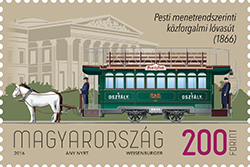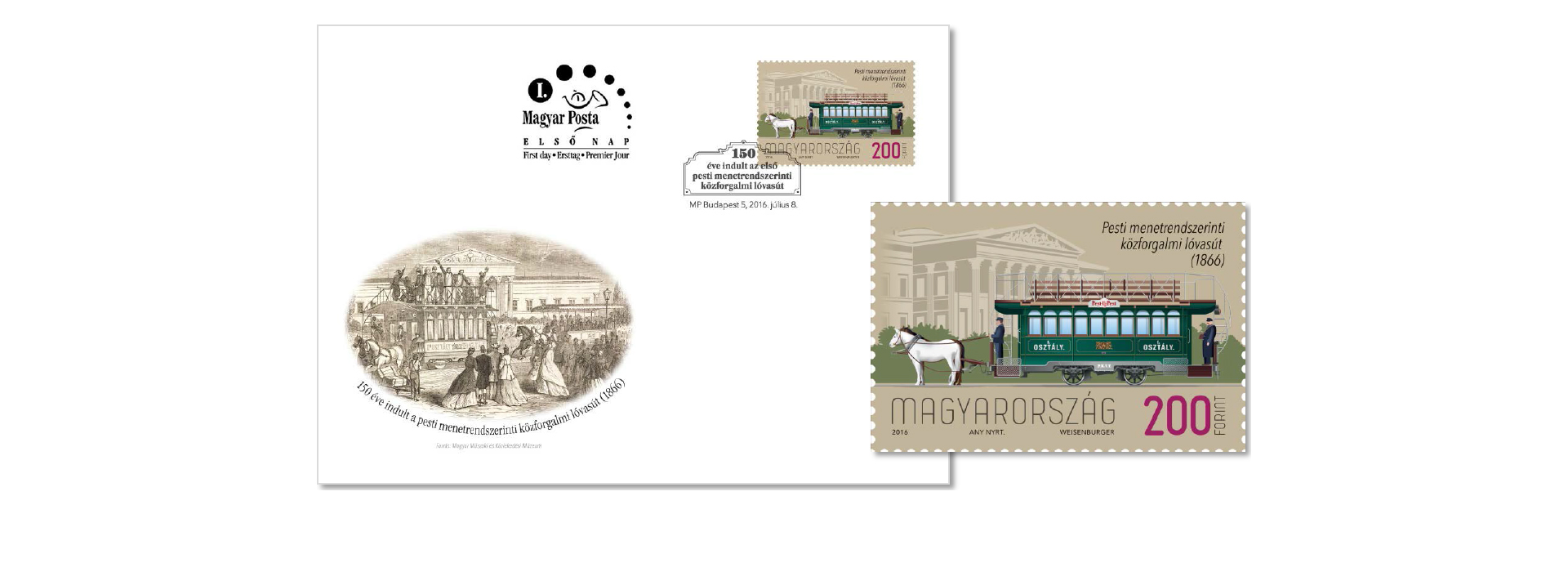FIRST SCHEDULED HORSE TRAMWAY IN PEST ENTERED SERVICE 150 YEARS AGO
The stamps are available in our webshop as well.
Magyar Posta is commemorating the one hundred and fiftieth anniversary of the first scheduled horse-drawn tram entering service in Pest by issuing a special stamp. The former vehicle depicted in the stamp was reconstructed based on available sources and a detail of the illustration with the caption The horse tramway in Pest initialled F.L. that appeared in the Sunday paper Vasárnapi Ujság on 22 July 1866 is shown on the cover. Source material for the issue was provided by the Hungarian Museum of Science, Technology and Transport. One hundred and fifty thousand copies of the stamp designed by the graphic artist István Weisenburger were produced by ANY Security Printing Company. The new issue is available at first-day post offices and Filaposta in Hungary from 8 July, but may also be purchased from Magyar Posta’s online store.
 The horse tramway was the first means of transport that was able to satisfy the needs of public transport. At the time it was modern, relatively fast and regular, connecting remoter parts of the ever expanding city. The first line was built from Széna Square and the terminal building in Újpest (today Kálvin Square and the Újpest-Városkapu intermodal transport node respectively). The Pest Tramway Company, established in 1865, was granted a licence to lay the track.
The horse tramway was the first means of transport that was able to satisfy the needs of public transport. At the time it was modern, relatively fast and regular, connecting remoter parts of the ever expanding city. The first line was built from Széna Square and the terminal building in Újpest (today Kálvin Square and the Újpest-Városkapu intermodal transport node respectively). The Pest Tramway Company, established in 1865, was granted a licence to lay the track.
After the ceremonial opening on 30 July 1866, the first service began on 1 August, which carried 57,000 people in the first month alone. Officially, it took 35 minutes to travel the nine kilometre track from Széna Square, stopping at the National Museum, the Zrínyi Café at Astoria, the Evangelical-Lutheran church in Deák Square, St Stephen’s Basilica, the Western Railway Station terminal and the “Small Beer Hall” at Lehel Square. Once on the section in Váci Road, the tram could be stopped anywhere by passengers until reaching the terminus in Újpest. Count Károlyi ensured that there was a fitting building to receive passengers arriving in Újpest. The decorative terminal building, popularly called the Owl’s Castle, was designed by János Wagner and constructed in 1866-67.
The line was extended to Rákospalota in 1872 along Árpád Road via István Road, Görgey Artúr Street, Szilágyi Street, Pozsony Street and Kertköz Street. The horse tramway’s role declined rapidly when electric trams came into service and closed down in 1900.
Source: mmkm.hu; bkv.hu; pestbuda.hu; wikipedia.org



